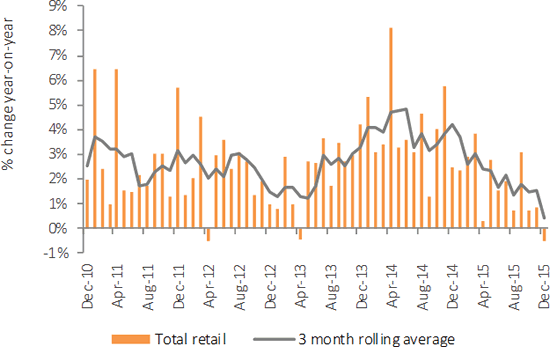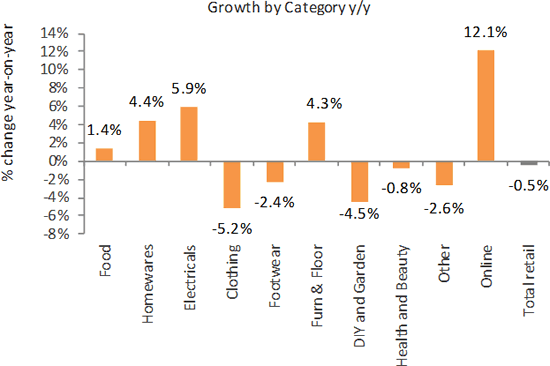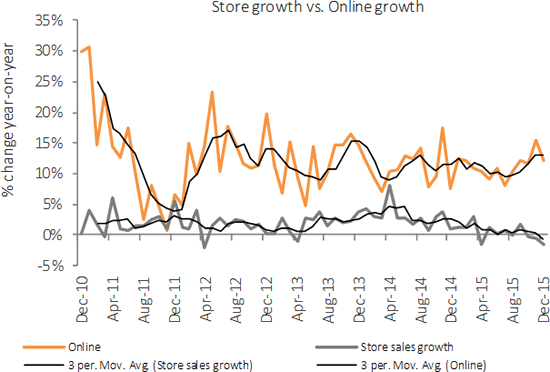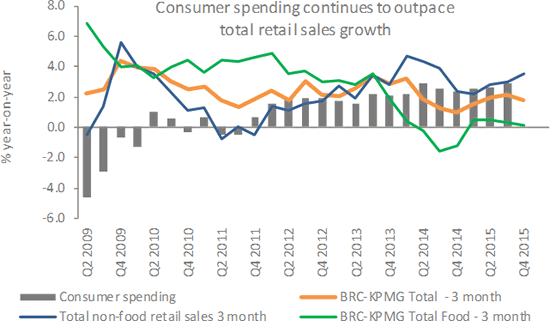Christmas sales flop with bricks and mortar in sharpest decline since May 2009
Retail sales fell by 0.5 per cent year-on-year (non-seasonally adjusted) in December according to the Retail Economics Sales Index. The three month rolling average, which provides a more accurate underlying trend, fell to +0.4 per cent, the lowest since July 2009.
Retail Economics Sales Index: Total retail sales
Source: Retail Economics - Retail Sales IndexThese figures are surprisingly weak given the strong underlying momentum behind consumer spending. Deep and widespread discounting throughout the industry failed to inspire consumers to leave their homes and shop on the high streets. According to the ONS, average store prices fell by 3.2 per cent in December, year-on-year, the 18th consecutive month of falling prices.

Source: Retail Economics - Retail Sales IndexUnseasonably mild and wet weather is likely to have played a significant role in holding back sales growth, especially across Clothing and Footwear. December turned out to be the wettest on record with +190 per cent of the average rainfall. This hit clothing retailers the hardest with sales falling 5.2 per cent, year-on-year, according to the Retail Economics Sales Index. Anecdotal commentary from a number of clothing retailers suggested that winter-wear and heavier items were shunned by shoppers and deep discounts were needed to shift stock. Meanwhile, Food sales were remarkably robust, given the recent trend, suggesting that the boost in disposable incomes transitioned to families splashing out on festive nibbles and trading up across some brands. Trading updates for the Big Four (Tesco, Sainsbury’s, Morrisons, Asda) food retailers all posted positive results which exceeded expectations. Food sales rose by 1.4 per cent over the period. This is the strongest result since June 2014, excluding Easter distortions. With food deflation running at 2.9 per cent, it suggests volumes had increased by c.4.3 per cent in December. Total online sales performed robustly, although growth declined on the levels seen in November. In December, Online retail sales rose by 12.1 per cent, year-on-year, compared with 15.6 per cent in the previous month.

Source: Retail Economics analysisAccording to the ONS, Department Stores saw online sales up 27.1 per cent in December. Household Goods Stores rose even faster at 33.1 per cent. A comparison of online and store sales growth revealed that in December total Store sales declined by 1.5 per cent while Online sales rose by 12.1 per cent. This is the sharpest decline in Store sales since May 2009. While temporary factors such as the mild weather and rainfall are likely to have played a role in the dismal December trading period, there is a growing body of evidence which suggests there are greater structural challenges at play.

Source: ONS, BRC, Retail Economics analysisA comparison of consumer spending growth versus total sales growth (BRC Retail Sales Monitor) reveals that consumer spending has now outpaced retail sales growth for 18 months. This is the first time in over 10 years. The latest data available showed an additional £9.6 billion of domestic consumer spending compared with the previous year - up 0.8 per cent. Recreation and Culture, Transport and Housing are the areas to have benefited the most from this additional spending.

Source: ONSOf the additional £9.6 billion spending compared with the previous year, Recreation and Culture and Transport accounted for over half. The proportion of consumer spending accounted for by the retail sector has been falling for many years, but this trend appears to accelerating. Digital and online has caused a structural change in household spending habits. The pursuit of experiences and service-based consumerism over material goods has shifted spending away from traditional retail. The flood of cheap goods into the UK over the last 10 years has arguably led to a saturation of household products. Although the fundamentals underpinning UK households remain robust, the boost in consumer spending has not flowed through to the retail sector in the manner that would have been expected just a few years ago. Admittedly, the growth of Non-Food shows a more favourable comparison. Nevertheless, over the last 12 months, Non-Food sales growth has struggled to keep pace with consumer spending having consistently outpaced it in the previous three years. This shift to a more experiential based retail experience will favour retailers in out-of-town retail parks, where destinations have a greater mix of retail and leisure.
Back to Retail Economic News